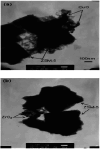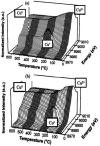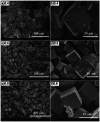Recent advances in supported molecular sieve catalysts with wide temperature range for selective catalytic reduction of NO X with C3H6
- PMID: 35517600
- PMCID: PMC9059638
- DOI: 10.1039/c8ra08635d
Recent advances in supported molecular sieve catalysts with wide temperature range for selective catalytic reduction of NO X with C3H6
Abstract
NO X is a major atmospheric pollutant that is emanated by motor vehicles, thermal power plants, and industrial boilers. Therefore, the removal of NO X is a research hotspot in the exhaust gas treatment field. Numerous methods have been used to eliminate NO X : the selective catalytic reduction of NO X using C3H6 as the reducing agent (C3H6-SCR) is an effective method to remove NO X . The key issue in NO X removal in C3H6-SCR is to obtain catalysts with low-temperature activity and wide operating temperatures. Till date, different supported wide-temperature-active molecular sieve catalysts have been prepared and used in C3H6-SCR reactions. Studies have shown that the catalytic performance of supported catalysts is related not only to the active component but also to the structural and textural parameters of the molecular sieve supports. This review summarizes the structural and textural characteristics, catalytic properties, and catalytic mechanism of molecular sieve catalysts with different pore structures for C3H6-SCR reactions. The design strategies of supported molecular sieve catalysts are suggested. The goal of this review is to highlight (1) the structural and textural characteristics and low-temperature catalytic performance of different supported molecular sieve catalysts; (2) the relationship between wide-temperature window and loaded active components, as well as carriers of the supported molecular sieve catalysts; and (3) design strategies and development prospects of supported molecular sieve catalysts with low-temperature activity and wide-temperature operating range for C3H6-SCR reactions.
This journal is © The Royal Society of Chemistry.
Conflict of interest statement
Authors declare no conflict of interest.
Figures
















Similar articles
-
Progress of selective catalytic reduction denitrification catalysts at wide temperature in carbon neutralization.Front Chem. 2022 Aug 17;10:946133. doi: 10.3389/fchem.2022.946133. eCollection 2022. Front Chem. 2022. PMID: 36059869 Free PMC article. Review.
-
Characterization and performance of Pt/SBA-15 for low-temperature SCR of NO by C3H6.J Environ Sci (China). 2013 May 1;25(5):1023-33. doi: 10.1016/s1001-0742(12)60107-7. J Environ Sci (China). 2013. PMID: 24218834
-
Low temperature performance and sulfur resistance enhancement of Mn-Ce oxides supported on W-modified MWCNT for NH3-SCR removal of NOx.J Air Waste Manag Assoc. 2021 Jun;71(6):689-700. doi: 10.1080/10962247.2021.1873205. Epub 2021 Feb 5. J Air Waste Manag Assoc. 2021. PMID: 33428540
-
Trimetallic FeNiCu Atomic Clusters Supported on Carbon Matrix: Highly Active Catalysts for C3H6-SCR of NO.ACS Appl Mater Interfaces. 2024 Nov 27;16(47):64664-64680. doi: 10.1021/acsami.4c11698. Epub 2024 Nov 18. ACS Appl Mater Interfaces. 2024. PMID: 39552407
-
An overview of the deactivation mechanism and modification methods of the SCR catalysts for denitration from marine engine exhaust.J Environ Manage. 2022 Sep 1;317:115457. doi: 10.1016/j.jenvman.2022.115457. Epub 2022 Jun 11. J Environ Manage. 2022. PMID: 35751261 Review.
Cited by
-
Progress of selective catalytic reduction denitrification catalysts at wide temperature in carbon neutralization.Front Chem. 2022 Aug 17;10:946133. doi: 10.3389/fchem.2022.946133. eCollection 2022. Front Chem. 2022. PMID: 36059869 Free PMC article. Review.
-
Radical-dominated reaction of CO-NO on a CaFe2O4 surface in sintering flue gas recirculation.RSC Adv. 2020 Jun 19;10(39):23491-23497. doi: 10.1039/d0ra00064g. eCollection 2020 Jun 16. RSC Adv. 2020. PMID: 35520328 Free PMC article.
-
Enhanced electrocatalytic properties in dye-sensitized solar cell via Pt/SBA-15 composite with optimized Pt constituent.Heliyon. 2023 Nov 14;9(11):e22403. doi: 10.1016/j.heliyon.2023.e22403. eCollection 2023 Nov. Heliyon. 2023. PMID: 38045216 Free PMC article.
References
-
- Yashnik S. A. Salnikov A. V. Vasenin N. T. Anufrienko V. F. Ismagilov Z. R. Catal. Today. 2012;197:214–227. doi: 10.1016/j.cattod.2012.08.033. - DOI
-
- Boix A. V. Aspromonte S. G. Miró E. E. Appl. Catal., A. 2008;341:26–34. doi: 10.1016/j.apcata.2007.12.032. - DOI
-
- Li G. Wang X. Jia C. Liu Z. J. Catal. 2008;257:291–296. doi: 10.1016/j.jcat.2008.05.007. - DOI
-
- Lónyi F. Solt H. E. Valyon J. Boix A. Gutierrez L. B. Appl. Catal., B. 2012;117:212–223. doi: 10.1016/j.apcatb.2012.01.022. - DOI
-
- Rico-Pérez V. García-Cortés J. M. De Lecea C. S. M. Bueno-López A. Chem. Eng. Sci. 2013;104:557–564. doi: 10.1016/j.ces.2013.09.052. - DOI
Publication types
LinkOut - more resources
Full Text Sources
Other Literature Sources

